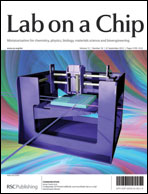Hydrodynamic trapping of Tetrahymena thermophila for the long-term monitoring of cell behaviors†
Abstract
Microfluidic trapping technology has been widely applied for single-cell observation in order to reveal characteristic cell behaviors. However, this strategy has yet to be tested for monitoring highly motile cells, which are often biologically important. In this paper, we seek the conditions that enable effective and long-term trapping of a prominent model ciliate Tetrahymena thermophila within a hydrodynamic microfluidic device. Although motility and flexibility of T. thermophila make it difficult to avoid escaping from the trap, we show that tuning some key parameters in the hydrodynamic circuit was effective to achieve approximately 40 h cell retention, which is long enough to monitor cell behaviors over several generations. Here, we demonstrate the real-time observation of cell division and phagocytic digestion, revealing interesting phenomena such as a wide distribution in doubling time in a poor synthetic medium and heterogeneous time courses in digestion processes. Our results present a strategy for trapping highly motile ciliate cells in order to study the dynamic behaviors of single cells.


 Please wait while we load your content...
Please wait while we load your content...